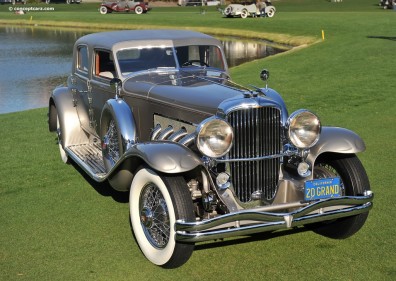
Here is something like the Model A in which Dad drove Mom out to Detroit in 1948 to start their new lives in the Motor City’s rip-roaring auto industry. It was used, of course, having been husbanded by someone through the gas rationing and rubber shortage of the war years. Look at how the design screams “antique,” and yet it was driving around Detroit almost into 1950.
Dad had used the GI Bill to attend Pratt Institute of Design in Brooklyn, and here is one of the rendering that got him hired at Ford’s, based on the recommendation of “Uncle Bob,” who wrote and said: “They are hiring!”
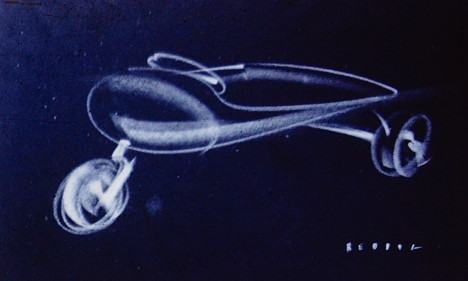
(Rendering of a child’s toy Raven did for his portfolio at Pratt Institute- you can see the sleek lines he loved.)
They packed up that Model A and drove West to Michigan. The road they traveled was partly the Pennsylvania Turnpike, The toll road- the first in America- was planned in the 1930s to improve transportation across the Appalachian Mountains, and used seven tunnels bored through the hills in the 1880s for the abandoned South Pennsylvania Railroad. I could wax eloquent about the Turnpike- and its sister, the Ohio Turnpike, but this just demonstrates how hard it is to separate the cars and the car people and the roads on which we drove.
This is what Dad stepped up to- the sleek 1948 two door I remember from my boyhood:
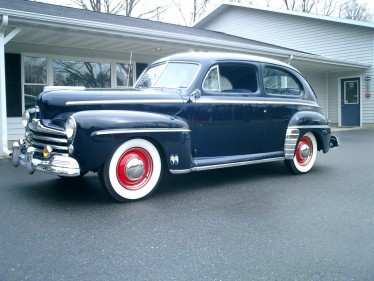
(1948 Ford Tudor. Compare the lines with the Model A. Sleek.)
I will get back to the Dwight Eisenhower Interstate and Defense Highway system some other time- Ike had been a Major on the epic Army convoy across America in 1919 that started near where Big Pink stands today. But I can’t even get back to the seminal moment in my early driving life on Woodward Avenue and I have been trying for more than a week.
Dad joined a talented team of Ford designers- a sample of the way they inducted the young men into the system is in this 1955 account of a tour conducted by Ford’s Alex Tremulis for Henry Ford II (we called him “the Deuce” in Detroit) and members of the Product Planning Committee that his people were on top of the future.
Dad was already over at American Motors by then as assistant head of styling, but the Tremulis orientation to the Advanced Design Studio shows how the system worked. Dad told me that he had worked on some wild things- the turbine-powered Ford and the Levacar among them. I can’t make the timeline work in my head.
The Levacar Mach 1 (a name later applied to a Mustang model) was shown at the Rotunda in 1959- I remember being taken there to see it, but of course it never went anywhere. It was intended to be personal transportation with no wheels, just an air cushion. Top speed was intended to be 500mph, though of course the whole braking concept would have required some sort of vector thrust technology that did not come to the missile industry until the Space Age began in earnest.
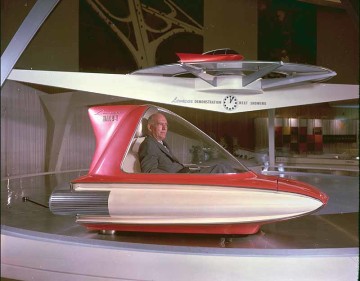
(The Levacar Mach 1, shown at the fabled Ford Rotunda, the Albert Kahn-desinged marvel of the 1934 Worlds Fair that was moved to Dearborn to serve as the entry point to the Ford World Headuarters. It burned to the ground in 1962 shortly after my last visit, which I had nothing to do with. The structure was circled with components of the famous highways of the world, including the Appian Way and the Burma Road. I assume that is still there- and I will get around to visiting the next time I am up there).
There was more from the Advanced design guys- they introduced several versions the year before in 3/8-scal, including the Volante, which supposedly could use three fan motors to levitate from a parking place and take to the air. But the most amazing of these models was the Nucleon. What may have looked like a Continental kit sitting on the large and flat rear deck was the cover for a small nuclear reactor that would power the car through the Atomic Age.
My Pal Tom collects Packards, and is as hard core a car person as you get. He commented on the merger and acquisition strategy among the pre-war legacy carmakers in the go-go 1950s:
“George Mason and James Nance, Packard’s president, had a handshake agreement to resume merger talks once Packard completed the acquisition of Studebaker. Nance was NOT a car person. He came from Hotpoint, where he proved he could make and sell washing machines. He made one unfortunate move after another while at Packard. One of them was a 1956 financial tie-up between the venerable Curtiss-Wright Aircraft company and floundering Studebaker-Packard: an air car to compete with what was happening at Ford’s.
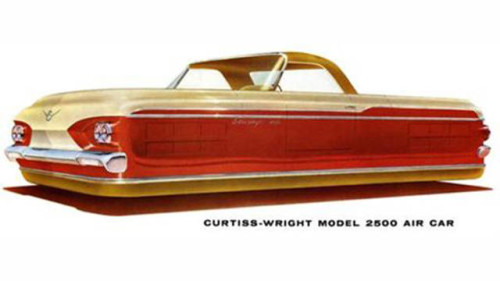
The thing was an enormous, blocky body fashioned after the automotive styling of the day, complete with twin headlights, turn signals, fenders, and bumpers.
That was just one of the things on which Nance blew the Studebaker patrimony.
He completed the Studebaker merger but, by the time he did, Mason had died and a guy named Romney was in charge at AMC. Romney took one look at the Studebaker-Packard merger and cancelled any notion of merging with them. He thought Nance was nuts and had done little or no due diligence before he rushed into the Studebaker deal. Romney was right. In 1956 Packard shut down the Connor Avenue plant that they had just bought from Chrysler for the ’55 and ’56 models and left Detroit for South Bend, IN. They put out a few “Packards” in 57 and 58, but they were just re-badged Studebakers. The 1958 Packard sold fewer than 2,000 cars! And that was the end.
It’s interesting to speculate on what might have happened had Packard (sans Studebaker) merged with AMC in 1954. AMC did not have an entry in the luxury car market, and Packard could have filled that niche. Other than the periodic re-appearance of the never-very-successful Imperial, Chrysler didn’t have a true luxury car either. Perhaps the Packard brand could still be alive as part of Chrysler Corporation!
Always interesting to speculate on what might have been. In any case, the demise of Packard is a case-book study on mis-managing a company which was profitable in 1954 and gone in 1958!”
Sigh. That is how it goes, trying to capture a century of cruising around America. I was going to talk to you about Fins today, and wound up over with the Levacar. They were exciting times. Just imagine if the old heap on blocks in the side yard came with a nuclear reactor. It would be like the vast fleet of hulk nuclear submarines sinking at the piers in the former Soviet Union.
But of course, all markets have their cycles, don’t they? Russia seems to be carving out an increasing market share these day, you know?
Back to Dad and the fins and where they came from tomorrow.
Copyright 2014 Vic Socotra
www.vicsocotra.com
Twitter: @jayare303
